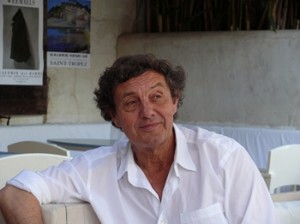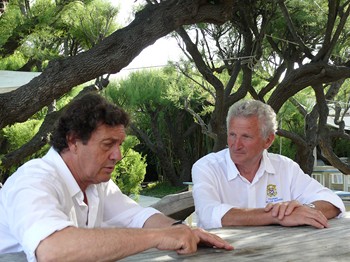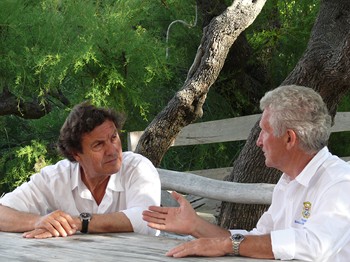Heirs to the Nioulargue, the Voiles de Saint-Tropez express an exceptional alchemy, a combination of the pleasure of sailing and an innate sense of celebration. Patrice de Colmont, director of Club 55 and founder of the event, and André Beaufils, Past-President of the SNST, testify.

It is said that the origin of Les Voiles de Saint-Tropez lies in a meeting that took place over thirty years ago. How did it all start?
Patrice de Colmont. By a happy coincidence! At the end of September 1981, an American couple with a competition Swan stayed in Saint-Tropez after having competed in the Swan Cup in Porto Cervo. They took part in a few regattas at the SNST, got to know some people and, one day, while the owner was talking about his successes in regattas, the 12 Meter Ikra entered the port. Someone said, “What about Ikra, do you think you could beat her? Immediate answer: “Why not, if Ikra accepts the challenge. I immediately ran to Jean Laurain, skipper of Ikra, who agreed to go out for a regatta the next day. That’s how it all started, with a crazy challenge between a Swan 44 and a 12 Meter JI!
It was already the alliance of the ancient and the modern. What was the outcome of the fight?
Patrice de Colmont. On the morning of the departure, with a friend, we want to buy a marine map to define the route. But we find it too expensive and we fall back on a road map where we pencil in the blue zone marked “golfe de Saint-Tropez”! The start is given in front of the Portalet tower, we turn the buoy of the Nioulargue shoal and the finish is judged in front of my house, at the Club 55, where a big table is waiting for everyone. Ikra comes first, well ahead of Pride, the Swan 44, but all that is secondary. The crews have lunch together and, as a trophy, I present the winner with a silver compotier from the French Navy’s crockery. The atmosphere is in full swing when the correspondent of Var Matin arrives and asks who these people are who seem to be having so much fun. I explain to him that it is a regatta. “Ah! What regatta?” I answer : “But… the Club 55 Cup !” and the crews add to this by declaring : “It was very hard, a high level challenge, we will have our revenge next year”, etc. The next day, the headline in Var Matin: “A new America’s Cup is born!
And that was enough to launch the event?
Patrice de Colmont. No, of course not. We had almost forgotten all about it when, the following September, in 1982, our American friend insisted on taking his revenge and other boats wanted to join the challenge. So a second edition was organised with a few disparate boats including, among others, the one-tonner Fantomas, Queen of Sheeba, a Belgian boat, Helisara and also Bourru III, an old auric cutter and the only classic boat of this second edition. The prize-giving ceremony was once again the occasion for a joyful mix of genres between the mayor awarding the town medal and the Belgians winning their weight in potatoes. I think there was even a pumpkin as a prize! That’s when a friend of ours, Gouédard, arrived, someone who was quite determined and who told us: “If there are no maxis, your thing is not a regatta! We looked at each other, for a moment dumbfounded, and we said to each other without really knowing what it was all about: “If that’s all there is, we’ll invite maxis.”

But it was a very organised class at the time, a very closed club. How did you go about it?
Patrice de Colmont. According to the first information obtained, it was unthinkable to make them come, so the biggest bluffing operation in world yachting began. A telex was sent to the Aga Khan, president of the Costa Smeralda Yacht Club where the second round of the Maxi World Championship was taking place, saying: “The Yacht Club of Saint-Tropez (which did not exist!) would like to present its regatta programme to the Maxi owners, could you organise a meeting? Twenty-four hours later, we had an appointment. Serge Krasnianski, whose firm Kiss was making a name for itself, lent us his jet for a small group to fly to Sardinia. There we told our little story and were courteously turned away by the skippers. Before leaving, after having offered the owners all sorts of trinkets, polo shirts, cases of wine, cigars with the Nioulargue coat of arms, we organised a surprise breakfast for two hundred people on the very pontoon where the maxi yachts were moored in order to treat all the crews. Then we left, leaving the guys intrigued and very impressed.
It still looked like a failure…
Patrice de Colmont. Wait a minute! A few weeks later, we learn that the maxi Mistress Quickly is pointing her bow in the bay to have her electronics repaired in Port-Grimaud. Immediately we head over there and give them a hell of a welcome. To give you an idea of the atmosphere, when one of the crew complains about the noise of the clock in the bell tower which strikes every hour, Gouédard does not make one or two moves, rushes up the bell tower with his bare hands and blocks the hands by twisting them in place. Like that,” he said, “you’ll sleep in peace! The guys thought they had landed in a madhouse! Then they were invited to Saint-Tropez and the game consisted in keeping them there by organising a continuous party, dinners, crazy nights, bowls tournaments, anything. That’s when we created a new tradition: the Australian breakfast, beer and croissants at eight in the morning! Then Midnight Sun came along and we heard that Christian de Galéa, who had just released a new EP, was planning to come and run. As a result, the guys from Midnight are tempted to race as well and things get serious. Two boats, that made us a class, a cup… It was won! We ended up with four Maxis side by side in the harbour and, at the end of the race, François Carn, the class secretary, came to tell us that the Nioulargue would be included in the official Maxi class calendar from the following year.
But what was the idea behind it all?
Patrice de Colmont. To have fun! Only to have fun! We all worked like crazy during the summer season and when October 1st came around, it was a break. We wanted to use Saint-Tropez for our own pleasure and the regattas gave us a pretext to have a real party which was not glitter and artifice but where people could find genuine pleasure. We had no commercial goals and all extravagances were welcome! I compare the first Nioulargue to the annual lumberjack festival in the forests of the Great North. It’s about who can chop down their tree the fastest while the children tug on the rope and the women compete to produce the best blueberry pie! It was the same for us, but around the sea.
André Beaufils. It’s true, the sea was more important than sailing and, from 1984 onwards, categories were invented such as the “sea-explorers”, the “tropéziens-travailers”, the “tropéziens-marconi” to constitute classes where everyone was admitted. The parades, the disguises, the water games at the entrance to the port with the girls in their gêpières – the famous “girelles” -, the bowls competitions, all this was added spontaneously. Everything was good to have fun, people wanted to see something else, to have memories in their heads, to share all the ingredients to have a good time together. That said, the Nioulargue quickly gained an international audience and gave an unprecedented boost to restorations. Classic yachts developed thanks to people like Albert Obrist who started to dig into the archives to rebuild boats to their original condition. It was with successive editions that we saw the return of boats with authentic rigs. It was a complete change of mentality because it was also necessary to find and train crews to handle them.
The fatal accident in 1995 between the schooner Mariette and the 6 MJI Taos Brett marked the end of the Nioulargue and a certain state of mind. How did the Voiles de Saint-Tropez come about?
André Beaufils. After the accident there was a court case and the event was suspended until the judgement was handed down. However, the participants had become accustomed to meeting and for some years there was an end-of-season regatta for modern boats and a spontaneous gathering, without regattas, for the classics. In 1999, when the procedure was completed, the SNST was faced with a dilemma: to abandon everything or to continue. But the town, the sailors, and the local economic players were pushing for a revival. This is how, thanks to Thierry Catino, then president of the SNST, the Voiles de Saint-Tropez was born. Today, we welcome about three hundred boats, with a roughly equal number of modern and classic boats.
But the state of mind has changed, we no longer see young girls throwing buckets of water on the crews…
André Beaufils. It is the times, the rules and the boats themselves that have changed. Today, the race instructions stipulate that water games are forbidden, whereas in the past it was rather the opposite. A lot of crews sleep in hotels, these are evolutions that must be taken into account and we can no longer have the casualness of the first editions. Above all, we mustn’t forget that it was Patrice who did all the work to bring the boats here. Today, organising the Voiles de Saint-Tropez is easy, but we have moved on.

Don’t you miss the crazy atmosphere of the first editions of the Nioulargue?
Patrice de Colmont. There is no need for nostalgia because you never do the same thing twice. One day, Annabelle Buffet, the wife of the painter Bernard Buffet, was asked if she didn’t miss the Saint-Tropez of before and she had this perfect answer: “I don’t find the Saint-Tropez that I loved, but I know that my children love the Saint-Tropez of today. Well, for the regattas, it’s the same thing. The fleet of boats has never been so beautiful, we play to full houses and we know that all the great classics that come out of the shipyard will sail in Saint-Tropez one day or another. What more do you want?
André Beaufils. I remember the wonder of Eric Tabarly who said: “I never imagined that one day I would see in real life all that I had seen in books. Personally, I have to respect what Patrice has done and I take a lot of pleasure in watching over this organisation. Les Voiles de Saint-Tropez preserves a unique character. It is first of all a state of mind that we perpetuate and we do not forget the origin of our history.
Interview by Eric Vibart – 2009